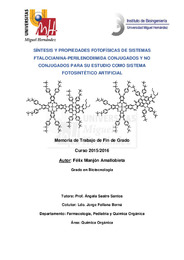Por favor, use este identificador para citar o enlazar este ítem:
https://hdl.handle.net/11000/3554Registro completo de metadatos
| Campo DC | Valor | Lengua/Idioma |
|---|---|---|
| dc.contributor.advisor | Sastre-Santos, Ángela | - |
| dc.contributor.advisor | Follana Berná, Jorge | - |
| dc.contributor.author | Manjón Amallobieta, Félix | - |
| dc.date.accessioned | 2017-04-26T12:14:46Z | - |
| dc.date.available | 2017-04-26T12:14:46Z | - |
| dc.date.created | 2016-09-20 | - |
| dc.date.issued | 2017-04-26 | - |
| dc.identifier.uri | http://hdl.handle.net/11000/3554 | - |
| dc.description.abstract | La demanda de energías renovables obliga a buscar nuevas formas de producir este tipo de energía con el fin de generar fuentes energéticas más respetuosas y eficientes que las actuales. Esto ha despertado el interés en el campo de la energía solar, donde la investigación se centra en la búsqueda de dispositivos capaces de aprovechar la luz solar y generar energía con una alta eficiencia. La Química Orgánica está consiguiendo avances muy importantes en el diseño y la síntesis de sistemas moleculares capaces de absorber la luz solar, produciendo el fenómeno de transferencia de cargas fotoinducida con el fin de aplicarlos en células fotovoltaicas y mejorar los actuales dispositivos que están en uso. Existen cantidad de moléculas capaces de sufrir estos fenómenos, como las ftalocianinas (Pc), los derivados de perilenos y los fullerenos (C60), entre otras. En este trabajo nos centraremos en la síntesis y caracterización de dos díadas que presentan en su estructura unidades de ftalocianina y perileno: el sistema conjugado ftalocianina-perilenomonoimidabenzoimidazol [ZnPc-PBIm(OR)4] y el sistema no conjugado ftalocianina-perilenodiimida [ZnPc-PDI(OR)4]. Los estudios de UV-vis, 1H-RMN y electroquímica revelan la interacción en el estado fundamental entre las subunidades del perileno y la ftalocianina en el sistema conjugado, mientras que carece de ella en el sistema no conjugado. Por último, las medidas de absorción transitoria ultrarrápida muestran que se forma un estado de separación de cargas en ambos sistemas, y que las velocidades de formación y recombinación son mucho más rápidas en el sistema conjugado que en el no conjugado | es |
| dc.description.abstract | The demand of renewable energies force to find new ways to produce this kind of energy in order to generate more efficient and respectful energetic sources than the current sources. This fact has awakened greatly the interest in the solar energy field, where the researchs are focused on searching of devices that are capable of use the sunlight and generate energy with a high efficiency. Organic Chemistry is achieving very important advances in the design and synthesis of molecular systems that are capable of absorb sunlight and then, they produce the photoinduced charge transfer phenomenom in order to use in photovoltaic cells and increase the current devices. There are lots of molecules that can suffer this phenomena, such as the phthalocyanines (Pc), perylene derivatives and fullerenes C60. We are going to focus on the synthesis and characterization of different conjugated phthalocyanine-perylenemonoimidebenzimidazole [ZnPc-PBIm(OR)4] and non-conjugated phthalocyanine-perylenediimide [ZnPc-PDI(OR)4] dyads. UV-vis, 1H-NMR and electrochemistry measurements reveal the interaction between perylene and phthalocyanine moieties in the ground state in the conjugated hybrid and the lack of interaction in the non-conjugated one. Ultrafast transient absorption measurements show that a state with substantial charge transfer character is formed in both compounds, but the rates for the formation and recombination from this state are much faster for the conjugated compound | es |
| dc.format | application/pdf | es |
| dc.format.extent | 37 | es |
| dc.language.iso | spa | es |
| dc.rights | info:eu-repo/semantics/openAccess | es |
| dc.subject | Ftalocianina | es |
| dc.subject | Perileno | es |
| dc.subject | Fotosintéticos artificiales. | es |
| dc.subject.other | CDU::5 - Ciencias puras y naturales::57 - Biología::577 - Bioquímica. Biología molecular. Biofísica | es |
| dc.title | Síntesis y propiedades fotofísicas de sistemas ftalocianina-perilenodiimida conjugados yno conjugados para su estudio como sistema fotosintético artificial | es |
| dc.type | info:eu-repo/semantics/bachelorThesis | es |

Ver/Abrir:
TFG Manjón Amallobieta , Félix.pdf
2,71 MB
Adobe PDF
Compartir:
 La licencia se describe como: Atribución-NonComercial-NoDerivada 4.0 Internacional.
La licencia se describe como: Atribución-NonComercial-NoDerivada 4.0 Internacional.
.png)